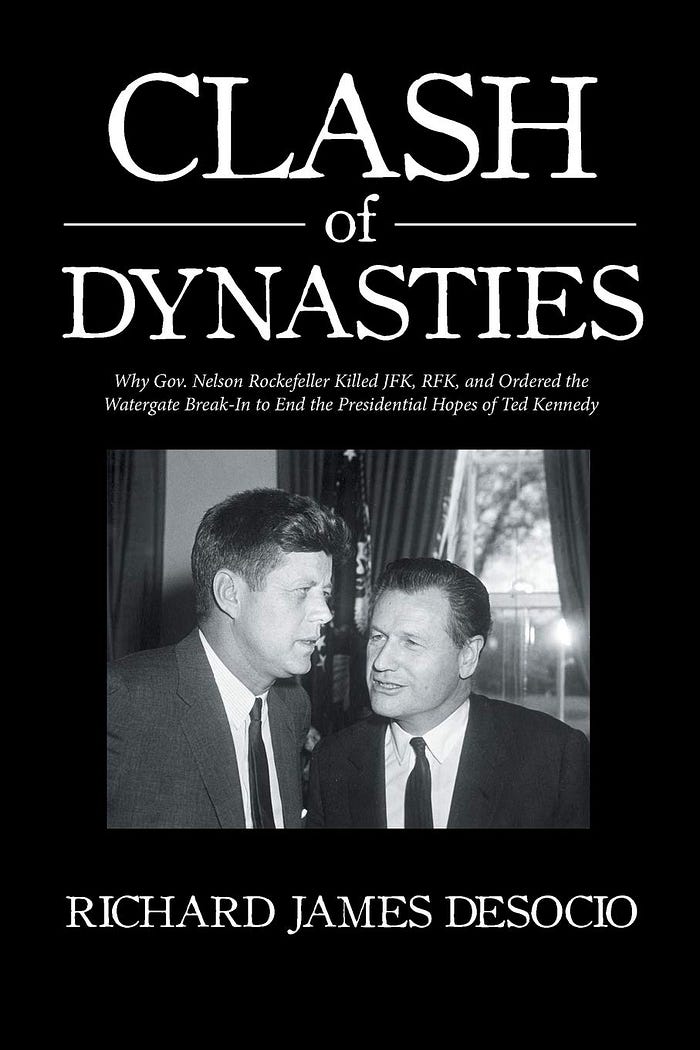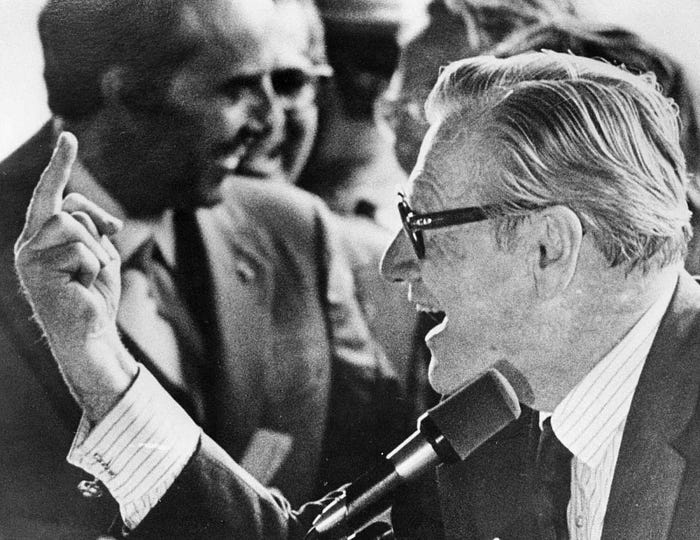When I was researching what became The Mad Bishops: The Hunt for Earl Anglin James and His Assassin Brethren, I started having my suspicions about Nelson Rockefeller. He was someone totally overlooked in my own formal education of American history. But as a native Clevelander, however, the Rockefeller name loomed large. Still, in the context of the crime ultime — the assassination of President Kennedy — a Rockefeller was noticeably absent as a chief suspect from most books and theories about November 22, 1963.
That is, except for the work of one Richard James DeSocio, author of the slambang self-published epic Clash of Dynasties: Why Gov. Nelson Rockefeller Killed JFK, RFK, and Ordered the Watergate Break-In to End the Presidential Hopes of Ted Kennedy, which he released in 2017 and is available on Kindle. It is an updated version of his previous effort, Rockefellerocracy: Kennedy Assassinations, Watergate and Monopoly of the “Philanthropic” Foundations from 2013.

While critics might argue DeSocio sees a Rockefeller everywhere, from under beds to behind Dell tower computers, his breadth of research and implications he proffers are not to be taken lightly; he just might be onto something. And given my own flirtation with a Rockefeller conspiracy — particularly in light of Nelson’s far-reaching Office of Inter-American Affairs and its obvious relationship to New Orleans, the Trade Mart, Dr. Ochsner, and likely connection to Dallas elite via the Good Neighbor Policy, among other things — Clash of Dynasties is certainly in line with my own suspicions.
The implications of the Rockefellers as those ultimately controlling the levers is almost glaringly obvious, but a brilliant disguise. DeSocio frames it as hiding in plain sight while hoodwinking a gullible public behind the veneer of charity foundations. What I especially liked about Clash of Dynasties is that DeSocio makes tangible connections back to the Rockefeller orbit with people directly connected to the events in Dallas. He’s made an overwhelming case, for instance, that George de Mohrenschildt was in the Rockefeller pocket, if not payroll. He also argued David Ferrie was as well. How? Through Eastern Air: both the location of the company and who financed it — Laurance Rockefeller, board member from ‘38-’60 and younger brother to Nelson and David. Eastern’s offices, furthermore, were located at 10 Rockefeller Plaza, and during the time in question the address was known as the Eastern Air Lines Building.
Additionally, the son of Hale Boggs was on the Eastern Air Board. DeSocio also goes through how those on the blue-ribbon Warren panel are even tied in to the Rockefeller universe — John McCloy and Allen Dulles, most notably. Two Rockefeller trustees.
But we are getting ahead of ourselves.
For DeSocio, the clash of dynasties did not begin in the twentieth century alone. Brazenly, DeSocio hearkens back deep in American lore to illustrate the illusion that is American democracy, the illusion of a republic. That the assault on the 35th president did not randomly manifest out of the placid landscape of Dealey Plaza, but was rooted deeper and darker. That Cuba did not appear as a zone of interest with the 26th of July Movement, but was a strategic pawn since TR and the Rough Riders conquered Cuba. Rather, according to DeSocio, elite families like the Roosevelts and Rockefellers have long dominated the trajectory and destiny of countries, its workers, and its resources. For quite awhile now, DeSocio believes, the Rockefellers have manipulated not only the structures of our societies, but have ensnared the 99% under its rule. And they’ve been doing this by spearheading major industrial and social change. Indeed, this morning I paid for my $5/gallon gas with a Chase MasterCard at a Chevron. As my father once said to me, “It’s not how much you make. It’s how much you owe.” DeSocio is trying to show us exactly it is who we owe — the same who evidently saw in the Brothers Kennedy enough of a threat to their hegemony.
Since we are dealing with the Rockefellers, oil, of course, dominates Clash of Dynasties. It also, funny enough, dominates the interests of those “patsying” Lee Oswald. Consider Oswald’s white Russian friend, petroleum geologist George de Mohrenschildt, who in his Warren Commission testimony said he had “the oil industry in my blood.” [DeSocio has plenty to say about de Mohrenschildt.] Then there’s oil tycoon D.H. “Dry Hole” Byrd, owner of the Texas School Book Depository, whom DeSocio reports “once operated 492 East Texas wells producing 4,000 barrels a day, and he later sold out to Standard Oil.” There’s Guy Banister, whom oil magnate H.L. Hunt retained to investigate Hunt’s oil operations in Louisiana, as reported by Jeffrey Caufield, and who occasionally met with Hunt at the Petroleum Club in Dallas. And there’s David Ferrie, Oswald’s Civil Air Patrol mentor, who was employed by Jeda Oil and Drilling prior to joining Eastern Air Lines.

DeSocio’s main suspect is Nelson Rockefeller, grandson of Standard Oil’s John D. Rockefeller, and four-term governor of New York (1959–1973). Anyone over a certain age, however — Nelson died in 1979, two years after the end of his unelected tenure as Gerald Ford’s VP — might not even recognize his name. Yet, young people would surely recognize the name and brand of his family: Rockefeller Center is a behemoth in the entertainment industry, home of 30 Rockefeller Plaza and immortalized by the hit NBC sitcom, 30 Rock, which solidified the careers of not a few A-listers. What DeSocio, a native New Yorker, admirably achieves that is irrefutable is pointing out the sheer connections to the JFK killing that circle back to Rockefeller Center, amounting to a de facto “private CIA” (to quote from Stephen Birmingham’s Our Crowd: The Great Jewish Families of New York). We have already mentioned Eastern Air (10 Rockefeller Plaza), but there is also Time-Life (1 Rockefeller Plaza), where the Zapruder film was sealed from the public for 12 years; defense contractor General Dynamics (1 Rockefeller Plaza), which garnered much attention in 1963 when it was awarded a $7 billion contract over Boeing for the TFX fighter; and book titans McGraw-Hill and Simon & Schuster, to name only a few. Why are these venerable American publishers of interest? Distributing school books from these publishers was the business of the Texas School Book Depository; McGraw-Hill’s office was on the fourth floor of the Book Depository. As DeSocio writes in Clash of Dynasties:
“If someone had the wherewithal to enter the 6th floor of the Texas School Book Depository and flipped open book covers, it would have read Rockefeller Center.”
Before moving on to the OSS and its location in Rockefeller Center, let’s talk more about NBC. I have written elsewhere how NBC affiliate WDSU New Orleans was hellbent on sullying Lee Oswald the weekend of the assassination — and before. Like when a WDSU cameraman happened to record Oswald handing out Fair Play for Cuba Committee flyers in August 1963. Or when WDSU-AM broadcast the Oswald-Bringuier-Ed Butler debate held three days later. Or when Oswald recorded a filmed interview in the WDSU-TV studio after the debate, which WDSU executives passed on to the FBI. For some reason, David Ferrie called WDSU from Houston’s Alamotel during his totally innocent and quaint jaunt to skating rinks the weekend of the assassination.
Operation Mockingbird, courtesy of Rockefeller Center?
45 Rockefeller Plaza was also the International Building, hub for 19 consulates prior to WWII as well as the covert counterintelligence branch of the FBI, the Special Intelligence Service. And it was also where William “Wild Bill” Donovan oversaw the forerunner of the CIA, the OSS. Allen Dulles ran the bureau’s New York Office out of Room 3603 at 30 Rock before he moved to Switzerland. 3603 was also headquarters of the British Security Coordination, helmed by William Stephenson, a Churchill appointee. We could really get into this connection, of the British-American-Canadian Corporation, of the World Commerce Corporation, of Otto Skorzeny.
But it was Nelson Rockefeller’s own role as Coordinator of Inter-American Affairs — which DeSocio argued was the true forerunner of the CIA, and which, needless to say, operated from Rockefeller Plaza — that was the lifeblood of pre-Langley American intelligence. It was also the angle that caused me to pause. What was Inter-American Affairs? I had never paid it any heed. But Life magazine did, which put Nelson Rockefeller on its cover for April 27, 1942, touting his role as Coordinator and boasting of its enormous budget ($45 million in 1942 money), his 500 personnel, and its noble purpose: to root out firms and individuals sympathetic to the Nazis. Eventually, Nelson would oversee 1,500 employees in the department. While attention was diverted to Europe and the Pacific, Nelson Rockefeller lorded over Latin America like a conqueror.
I dare not reveal all of what DeSocio uncovers and proposes in Clash of Dynasties. Of Michael Paine. Jack Ruby. Organized crime. Hoffa. Cuba. Watergate. It is both exhausting and exhaustive. Facts and family ties pour out with conviction and feverishness. He is a writer with something to say — one senses this has been brewing inside DeSocio for decades — and it might be easy to dismiss his theory…if it wasn’t so darn convincing.
I will mention one more nugget. While reading, I kept wondering if any reference to the Civil Air Patrol would emerge. Readers of my work know my suspicions of the CAP and its fingerprints in Dallas on November 22. I was not to be disappointed. To combat Nazi spies in New York harbor, “David Rockefeller as intern to the mayor formed the Civil Air Patrol to protect Standard Oil’s vessels.” The mayor at this time was Fiorello La Guardia. La Guardia was also the first director of the Office of Civilian Defense. Citing David Rockefeller’s autobiography, DeSocio notes Rockefeller interned for La Guardia in the Office of Civilian Defense.
Why and how this leads to the killing of the Kennedys is the subject of Clash of Dynasties. Does DeSocio succeed? It is an imperfect book, but the sense of urgency is palpable. Someone needed to talk about it (although DeSocio admittedly stands on the shoulders of Thy Will Be Done: The Conquest Of The Amazon Nelson Rockefeller And Evangelism In The Age Of Oil and the work of Emanuel Josephson).
Let’s put it this way: Between his extensive work in CAP, his piloting for Eastern Air Lines, his work for Jeda Oil and Drilling, there must now be little doubt Oswald’s mentor David Ferrie was not taking orders from the CIA, but from whom Richard James DeSocio says the CIA takes orders themselves: the Rockefellers.